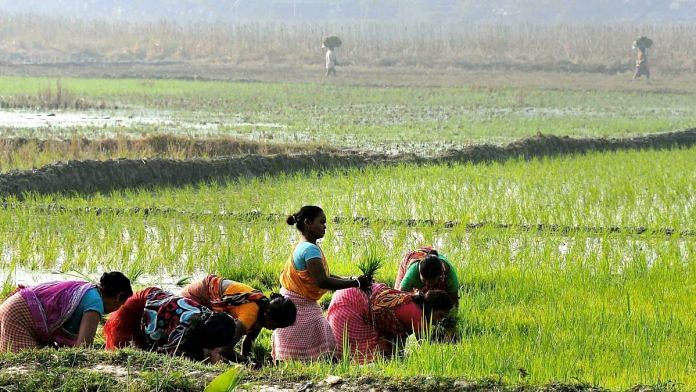The lasting legacy of this government will be that it oversaw the lowest average growth rate of agriculture in almost three decades.
As the Narendra Modi-led government readies to present its fifth and final full-year budget, many are hoping that the government’s focus will finally fall on filling the farmers’ empty plate.
In the last four years, the government has been a mute spectator to the stress building up in the rural heartlands. Prices of all major agriculture produce have been under pressure while cost of farming has increased. The surplus in farm exports has steadily eroded from $28.2 billion in 2013-14 to just $8.7 billion in 2016-17. Imports of agriculture produce have increased by 66 per cent in the same period to $25.09 billion while exports have dropped from $43.2 billion to $33.8 billion.
The outstanding farm loans have swollen to about Rs.14.3 lakh crores. The situation in some states is so grim that even rural brides are shunning farming lads and according to the recently released ASER survey, just 1.2 per cent of rural teens, aged between 14 and 18, aspire to be farmers.
In all likelihood, the lasting legacy of this government will be that it oversaw the lowest average growth rate of agriculture in almost three decades. A dishonourable achievement for a government that swept into power with a slew of promises to make farming profitable. One year is too short to bring about a change of fortune in the lives of farmers but here are a few things that the government should consider to put agriculture back on the growth path.
Ignore Science at Nation’s Peril.
Who after all won the BT Brinjal battle? The short answer is multinationals. Who lost the BT Brinjal battle? Farmers. It is practically impossible to grow brinjal without bi-weekly sprays of new generation of insecticides from Dupont, Bayer and Syngenta to control fruit and stem borer. Farmers end up spending over Rs 12,000 per acre per cropping season on these insecticides alone. Meanwhile in Bangladesh, no one has turned into a Frankenstein’s monster by consuming BT Begun. While Australian cotton farmers have switched over to Bollgard 3 at a rapid rate since its introduction in 2015, our farmers are literally dying from inhaling deadly cocktail of pesticides to control pink ball worms, which have grown resistant to Bollgard II. A few domestic seed companies packaged their royalty payment issues with Monsanto under the blanket of nationalism to further muddle up the woes.
To complicate matters even more, just four companies will soon control almost the entire seed and crop protection chemicals businesses: Bayer–Monsanto, ChemChina–Syngenta, Dow–DuPont, and BASF. In this global consolidation, India is probably the biggest loser as the government neither trusts technologies developed by private sector nor by our own bootstrapped universities. The indigenously developed genetically modified mustard is a good example. The commercialisation of the technology has been deferred indefinitely despite the clearance from technical committee but it continues to allow huge imports of genetically modified canola and soybean oils.
Introduced in 2003, genetically modified soy has brought fortunes to Brazilian farmers. In Mato Grosso plains of Brazil, soy farmers drive Land Rovers as yields have reached about 2.76 metric tonne per hectare compared to the lowly 1.14t/ha our farmers are producing. It takes almost 8 cropping seasons for our farmers to produce what a Brazilian grows in just 3 years.
Instead of focussing all the resources on bridging the yield gap, the government has spent close to Rs 690 crore to create ‘organic clusters’ through Paramparagat Krishi Vikas Yojana.
Promoting organic farming is tantamount to offering fuel subsidies to a Ferrari owner. It is absolutely fine for individual farmers to ride the novel bandwagon but for government to dive headfirst is bordering on the absurd. Pesticide usage in India is among the lowest in the world, the push to further reduce it will be disastrous. Instead, Rs 690 crore would have gone a long way in setting up a robust local-level weather forecast along with pest and disease warning system. Such advisory increase yields and cuts costs. We should aspire to build a system similar to the US Department of Agriculture’s National Agriculture Statistics Services reports.
When global markets are increasingly deciding the fortunes of Indian farmers, shouldn’t it be the duty of the government to provide the same level-playing field as enjoyed by the overseas competitors? To whose benefit are our farmers being denied opportunities to step up their game? Why should it be a shocking surprise when someone accidentally discovers that progressive cotton farmers have resorted to farming by stealth by switching to unapproved Bollgard II RoundUp Ready Flex. It is only a matter of time before farmers bring in Bollgard 3 and BT Brinjal too. Abdicating responsibility of policy making to the fringe is a sure way of confirming that addition of “farmers’ welfare” to the agriculture ministry’s nameplate was for representational purpose only.
Aruna Urs farms in his ancestral village B.Tunga near Mysuru.




Puore
Middle Class Family ,I am a Farmer .